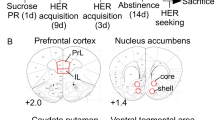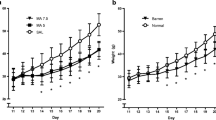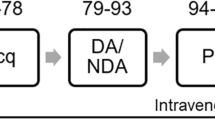Abstract
Rationale
Neonatal maternal separation (MS) has been used to model the effects of early life stress in rodents. MS alters behavioral responses to a variety of abused drugs, but few studies have examined its effects on methamphetamine sensitivity.
Objectives
We sought to determine the effects of MS on locomotor and stereotyped responses to low-to-moderate doses of methamphetamine in male and female adolescent rats.
Methods
Male and female rat pups were subjected to 3 h per day of MS on postnatal days (PN) 2–14 or a brief handling control procedure during the same period. During adolescence (approximately PN 40), all rats were tested for locomotor activity and stereotyped behavior in response to acute methamphetamine administration (0, 1.0, or 3.0 mg/kg, s.c.).
Results
MS rats of both sexes exhibited increased locomotor activity in a novel environment, relative to handled controls. MS increased the locomotor response to methamphetamine (METH), and this effect occurred at different doses for male (3.0 mg/kg) and female (1.0 mg/kg) rats. MS also increased stereotyped behavior in response to METH (1.0 mg/kg) in both sexes.
Conclusions
MS enhances the locomotor response to METH in a dose- and sex-dependent manner. These results suggest that individuals with a history of early life stress may be particularly vulnerable to the psychostimulant effects of METH, even at relatively low doses.




Similar content being viewed by others
References
Arborelius L, Eklund MB (2007) Both long and brief maternal separation produce persistent changes in tissue levels of brain monoamines in middle-aged female rats. Neuroscience 145(2):738–750
Bolanos CA, Glatt SJ, Jackson D (1998) Subsensitivity to dopaminergic drugs in periadolescent rats: a behavioral and neurochemical analysis. Brain Res Dev Brain Res 111(1):25–33
Brake WG, Zhang TY, Diorio J, Meaney MJ, Gratton A (2004) Influence of early postnatal rearing conditions on mesocorticolimbic dopamine and behavioural responses to psychostimulants and stressors in adult rats. Eur J Neurosci 19(7):1863–1874
Brecht ML, O'Brien A, von Mayrhauser C, Anglin MD (2004) Methamphetamine use behaviors and gender differences. Addict Behav 29(1):89–106
Creese I, Iversen SD (1974) The role of forebrain dopamine systems in amphetamine induced stereotyped behavior in the rat. Psychopharmacologia 39(4):345–357
Daniels WM, Pietersen CY, Carstens ME, Stein DJ (2004) Maternal separation in rats leads to anxiety-like behavior and a blunted ACTH response and altered neurotransmitter levels in response to a subsequent stressor. Metab Brain Dis 19(1):3–14
Desbonnet L, Garrett L, Daly E, McDermott KW, Dinan TG (2008) Sexually dimorphic effects of maternal separation stress on corticotrophin-releasing factor and vasopressin systems in the adult rat brain. Int J Dev Neurosci 26(3–4):259–268
Dluzen DE, Liu B (2008) Gender differences in methamphetamine use and responses: a review. Gend Med 5(1):24–35
Dube SR, Cook M, Edwards VJ (2010) Health-related outcomes of adverse childhood experiences in Texas, 2002. Prev Chron Dis 7(3):1–9
Faure J, Stein DJ, Daniels W (2009) Maternal separation fails to render animals more susceptible to methamphetamine-induced conditioned place preference. Metab Brain Dis 24(4):541–559
Festa ED, Russo SJ, Gazi FM, Niyomchai T, Kemen LM, Lin SN, Foltz R, Jenab S, Quinones-Jenab V (2004) Sex differences in cocaine-induced behavioral responses, pharmacokinetics, and monoamine levels. Neuropharmacology 46(5):672–687
Hall FS, Wilkinson LS, Humby T, Robbins TW (1999) Maternal deprivation of neonatal rats produces enduring changes in dopamine function. Synapse 32(1):37–43
Hensleigh E, Smedley L, Pritchard LM (2011) Sex, but not repeated maternal separation during the first postnatal week, influences novel object exploration and amphetamine sensitivity. Dev Psychobiol 53(2):132–140. doi:10.1002/dev.20499
Huot RL, Thrivikraman KV, Meaney MJ, Plotsky PM (2001) Development of adult ethanol preference and anxiety as a consequence of neonatal maternal separation in Long Evans rats and reversal with antidepressant treatment. Psychopharmacology (Berl) 158(4):366–373
Institute for Laboratory Animal Research (1996) Guide for the care and use of laboratory animals. National Academy Press, Washington D.C
Levine S (2001) Primary social relationships influence the development of the hypothalamic–pituitary–adrenal axis in the rat. Physiol Behav 73(3):255–260
Li Y, Robinson TE, Bhatnagar S (2003) Effects of maternal separation on behavioural sensitization produced by repeated cocaine administration in adulthood. Brain Res 960(1–2):42–47
Marin MT, Planeta CS (2004) Maternal separation affects cocaine-induced locomotion and response to novelty in adolescent, but not in adult rats. Brain Res 1013(1):83–90
Marmendal M, Roman E, Eriksson CJ, Nylander I, Fahlke C (2004) Maternal separation alters maternal care, but has minor effects on behavior and brain opioid peptides in adult offspring. Dev Psychobiol 45(3):140–152
Matthews K, Hall FS, Wilkinson LS, Robbins TW (1996) Retarded acquisition and reduced expression of conditioned locomotor activity in adult rats following repeated early maternal separation: effects of prefeeding, d-amphetamine, dopamine antagonists and clonidine. Psychopharmacology (Berl) 126(1):75–84
Matthews K, Robbins TW, Everitt BJ, Caine SB (1999) Repeated neonatal maternal separation alters intravenous cocaine self-administration in adult rats. Psychopharmacology (Berl) 141(2):123–134
Matthews K, Dalley JW, Matthews C, Tsai TH, Robbins TW (2001) Periodic maternal separation of neonatal rats produces region- and gender-specific effects on biogenic amine content in postmortem adult brain. Synapse 40(1):1–10
Meaney MJ, Brake W, Gratton A (2002) Environmental regulation of the development of mesolimbic dopamine systems: a neurobiological mechanism for vulnerability to drug abuse? Psychoneuroendocrinology 27(1–2):127–138
Messina N, Marinelli-Casey P, Hillhouse M, Rawson R, Hunter J, Ang A (2008) Childhood adverse events and methamphetamine use among men and women. J Psychoact Drugs S5:399–409
Milesi-Halle A, Hendrickson HP, Laurenzana EM, Gentry WB, Owens SM (2005) Sex- and dose-dependency in the pharmacokinetics and pharmacodynamics of (+)-methamphetamine and its metabolite (+)-amphetamine in rats. Toxicol Appl Pharmacol 209(3):203–213
Moffett MC, Vicentic A, Kozel M, Plotsky P, Francis DD, Kuhar MJ (2007) Maternal separation alters drug intake patterns in adulthood in rats. Biochem Pharmacol 73(3):321–330
Muhammad A, Kolb B (2011) Maternal separation altered behavior and neuronal spine density without influencing amphetamine sensitization. Behav Brain Res 223(1):7–16
Pihoker C, Owens MJ, Kuhn CM, Schanberg SM, Nemeroff CB (1993) Maternal separation in neonatal rats elicits activation of the hypothalamic–pituitary–adrenocortical axis: a putative role for corticotropin-releasing factor. Psychoneuroendocrinology 18(7):485–493
Planeta CS, Marin MT (2002) Effect of cocaine on periadolescent rats with or without early maternal separation. Braz J Med Biol Res 35(11):1367–1371
Ploj K, Roman E, Nylander I (2003) Long-term effects of maternal separation on ethanol intake and brain opioid and dopamine receptors in male Wistar rats. Neurosci 121(3):787–799
Plotsky PM, Meaney MJ (1993) Early, postnatal experience alters hypothalamic corticotropin-releasing factor (CRF) mRNA, median eminence CRF content and stress-induced release in adult rats. Mol Brain Res 18(3):195–200
Rosenfeld P, Wetmore JB, Levine S (1992) Effects of repeated maternal separations on the adrenocortical response to stress of preweanling rats. Physiol Behav 52(4):787–791
Sapolsky RM, Meaney MJ (1986) Maturation of the adrenocortical stress response: neuroendocrine control mechanisms and the stress hyporesponsive period. Brain Res 396(1):64–76
Schindler CW, Bross JG, Thorndike EB (2005) Gender differences in the behavioral effects of methamphetamine. Eur J Pharmacol 442(3):231–235
Shoblock JR, Sullivan EB, Maisonneuve IM, Glick SD (2003) Neurochemical and behavioral differences between d-methamphetamine and d-amphetamine in rats. Psychopharmacology (Berl) 165(4):359–369
Sinha R (2008) Chronic stress, drug use, and vulnerability to addiction. Ann NY Acad Sci 1141:105–130
Stanton ME, Wallstrom J, Levine S (1987) Maternal contact inhibits pituitary-adrenal stress responses in preweanling rats. Dev Psychobiol 20(2):131–145
Troakes C, Ingram CD (2009) Anxiety behaviour of the male rat on the elevated plus maze: associated regional increase in c-fos mRNA expression and modulation by early maternal separation. Stress 12(4):362–369
Walker QD, Morris SE, Arrant AE, Nagel JM, Parylak S, Zhou G, Caster JM, Kuhn CM (2010) Dopamine uptake inhibitors but not dopamine releasers induce greater increases in motor behavior and extracellular dopamine in adolescent rats than in adult male rats. J Pharmacol Exp Ther 335(1):124–132
Wobbrock JO, Findlater L, Gergle D, Higgins JJ (2011) The aligned rank transform for nonparametric factorial analyses using only ANOVA procedures. Conf Hum Factors Comput Syst-Proc 143–146
Zorrilla EP (1997) Multiparous species present problems (and possibilities) to developmentalists. Dev Psychobiol 30(2):141–150
Acknowledgments
This work was supported by grants from the National Center for Research Resources (5P20RR016464-11) and the National Institute of General Medical Sciences (8 P20 GM103440-11) of the National Institutes of Health. We would like to thank Kelly AbuAli and Alan Jager for their assistance with editing and scoring behavioral videos. The experiments described herein comply with the Public Health Service Policy on Humane Care and Use of Laboratory Animals.
Conflict of interest
The authors declare that they have no conflicts of interest.
Author information
Authors and Affiliations
Corresponding author
Rights and permissions
About this article
Cite this article
Pritchard, L.M., Hensleigh, E. & Lynch, S. Altered locomotor and stereotyped responses to acute methamphetamine in adolescent, maternally separated rats. Psychopharmacology 223, 27–35 (2012). https://doi.org/10.1007/s00213-012-2679-z
Received:
Accepted:
Published:
Issue Date:
DOI: https://doi.org/10.1007/s00213-012-2679-z




